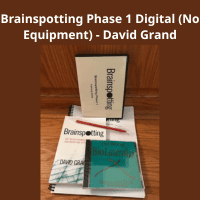Course Summary:
“Brainspotting Phase 1 Digital (No Equipment)” is a foundational training program developed by Dr. David Grand, the originator of Brainspotting. This course introduces participants to the core principles and basic techniques of Brainspotting, a powerful, focused treatment method that works by identifying, processing, and releasing neurophysiological sources of emotional pain, trauma, dissociation, and a variety of other challenging symptoms. Unique to this digital offering, the course emphasizes how to effectively utilize Brainspotting principles in a virtual or non-equipment setting, making it highly accessible for practitioners worldwide. It delves into the understanding that “where you look affects how you feel,” guiding learners through the process of locating “brainspots” – eye positions that correlate with activated subcortical brain activity connected to traumatic or emotionally charged experiences.
Target Audience:
This program is primarily designed for:
- Mental health professionals (e.g., therapists, counselors, psychologists, social workers) seeking to integrate an innovative trauma-processing modality into their practice.
- Medical professionals who wish to understand the neurobiological underpinnings of trauma and its resolution.
- Coaches and bodywork practitioners interested in complementary techniques for emotional release and well-being.
- Students in mental health fields who are looking to expand their therapeutic toolkit.
- Individuals interested in the neurobiology of trauma and advanced healing techniques.
Main Content (Likely Topics):
Based on the typical Phase 1 Brainspotting curriculum, this digital course likely covers:
- Introduction to Brainspotting: History, theory, and foundational concepts of how Brainspotting works.
- The Power of Focused Activation: Understanding the principle “where you look affects how you feel” and its application.
- Identifying Brainspots: Techniques for locating fixed eye positions that activate trauma or resource material.
- Outside Window and Inside Window Brainspotting: Learning these two primary methods for processing.
- Resource Brainspotting: Utilizing brainspots to access and strengthen internal resources for client stabilization.
- The Concept of “Felt Sense”: Connecting physical sensations to emotional and psychological experiences during processing.
- Attuned Presence of the Therapist: Emphasizing the importance of the therapist’s relational attunement.
- Neurobiology of Trauma and Brainspotting: Basic understanding of how Brainspotting impacts the brain and nervous system.
- Integration without Equipment: Practical guidance and adaptations for conducting Brainspotting sessions digitally or without physical pointers.
- Client Preparation and Debriefing: Ethical considerations and best practices for before and after sessions.
Learn the foundational techniques of Brainspotting for trauma resolution!
SIGN UP NOW







